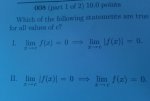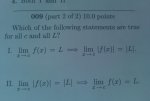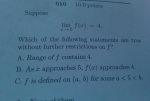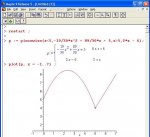Okay so I took AP Cal in high school and now I'm about to take it in college... Today my friend texted me asking me for help on limits since he is starting AP Cal this year and I originally thought it would be a piece of cake... Pff not so much. These problems involve absolute value so I was kind of stumped but had an idea of how to get the answer... I think. Let me upload the pics of the problems he sent me from his phone... I haven't really looked at 2 and 3 but for the first pic I believe that both conditions are true as the answer for the problem. I used x^3 as f(x) as well as x^2 and a couple linear equations as well and both parts got satisfied for problem one in each equation so I believe both must be true. Enough of me talking, here are the pics and someone please help me 
Thanks in advance,
Chris
** For some reason first problem is the last pic, second is second pic and third problem is first from top.
Edit: Just looked at Prob 2 and I believe both 1 and 2 are also true just as in problem one.. For some reason this seems wrong to me
Thanks in advance,
Chris
** For some reason first problem is the last pic, second is second pic and third problem is first from top.
Edit: Just looked at Prob 2 and I believe both 1 and 2 are also true just as in problem one.. For some reason this seems wrong to me




